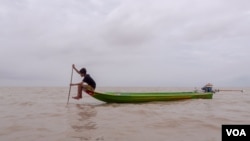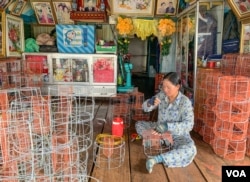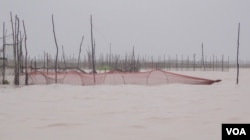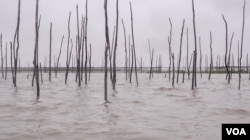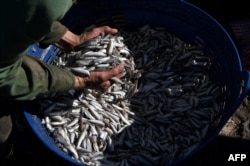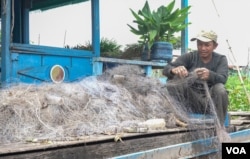KAMPONG LOUNG VILLAGE, PURSAT PROVINCE — Sitting in their floating home amid a pile of iron frames and netting, Kong Kouen and Hoeung Piseth are busy preparing hundreds of prawn traps that will be placed at the bottom of the Tonle Sap Lake.
It is hard work that will take several days to finish and requires significant financial investment from the couple. Nowadays, there is little guarantee that this long-established fishing technique will yield enough catch to sustain them and their four teenage children.
Overfishing, regional hydropower dam development and global climate change have pushed the lake into ecological crisis, and fishing communities are sinking into despair.
“Before, when I set a hundred of these iron traps, I could get 100 kilograms [of prawn], but now, though I set 1,000 or 2,000, I can't get any more than 20 kilograms,” Kong Kouen told VOA Khmer. She added that they spent about $1,500 to buy material for around 1,000 traps, which will last three years.
The prawn traps supplement the household income from daily fish catch, but this too, had halved in recent years. On some days, they go out fishing and come back with nothing and cannot even cover the cost of gasoline, fishing equipment and boat maintenance. Kong Kouen said she did not know how much longer they could afford to keep their children in high school.
Like their floating village of Kampong Luong, on the lake’s southern shore, the family and their fishing techniques move with the rising and receding water, and other seasonal changes in the Tonle Sap’s ecosystem and fish populations.
“We are the river people,” said Kong Kouen, using a Khmer term, Niak Tonle, for hundreds of thousands of Cambodians who live off the highly productive Tonle Sap Lake and Mekong River, which is connected to the lake through a tributary. “The lake, to us, is what the rice field is to the farmers,” she told VOA Khmer.
“How can I be secure and can go out and get fish?” she said. “If they can stop [illegal overfishing], my children can rely on this sector, but if not, it's the end. The next generation [has to be] ready to go away,” she said.
From the lake to the plantation
This concern is widely shared on the lake, where fishermen have for years reported a decline in catch and disappearance of certain species.
Recent VOA Khmer interviews with Tonle Sap communities and fisheries experts indicate this forced increasing numbers of fishers to go ashore to seek additional income or leave permanently. Most end up working as laborers on plantations, construction sites, or in factories in cities or in neighboring Thailand.
“The majority are poor and have to move out [to plantations] for work as laborers,” said Long Sochet, National Coordinator of Coalition of Cambodia Fishers (CCF). “Some bring their wife and children to other provinces, as far as Ratanakiri Province, to sell their labor in banana plantations.”
“The same trend [of outmigration] is happening across the Tonle Sap,” he said, adding that some work on plantations and return to the lake to resume fishing, while others leave for good.
Long Sochet said most migrating fishers become laborers and live on plantations instead of becoming farmers, as they lack significant assets that can serve as collateral for loans to buy farmland or housing plots.
“Those who have the ability to buy land—whether a small [housing] plot or farmland—and plan to reside permanently on land are a minority,” he told VOA Khmer.
Brian Eyler, a Mekong Basin expert at the Stimson Center in Washington DC, said, “Migration away from the Tonle Sap is likely over the last three years given record-low lake levels during the wet season, which translate to low fish catches.
“The Tonle Sap fishery is being depleted by various factors such as climate (low rainfall), dam impacts, unregulated fishing, and there will likely be a direct relationship between out-migration and fish catch into the future,” he wrote in a message.
Eyler added that before the catch became very poor in recent years, there were also reports of people coming to the lake, attracted by its traditional reputation for bountiful fisheries.
‘It’s difficult to answer your question’
Experts have warned for years that Tonle Sap Lake’s fisheries and livelihoods face collapse unless the Cambodian government takes effective action to address local causes and help fishermen.
Government officials acknowledged to VOA Khmer that the Tonle Sap is under severe stress, but denied this was creating significant outmigration as government measures were protecting fisheries and livelihoods.
“We don’t see this [migration] happening,” said Ing Try, Deputy Director General of Fishery Administration. “Our stance is that we create jobs. First, we recommend that they start fish farming… For women, we train them in mushroom cultivation for sale. We have our plans.”
Asked how the destitute fishermen were supposed to make the investments necessary for fish farming, Ing Try said, “It’s difficult to answer your question… because most of them are in debt.”
VOA Khmer was unable to find recent migration data to confirm Tonle Sap communities were emptying out, but the government’s Socio-Economic Survey indicates that households fishing on the Tonle Sap Lake numbered about 465,000 in 2019, a decline of 14 percent since 2009.
Nationwide, fishing fell 23 percent in this period to some 1.3 million households, or about a third of total population. Across Cambodia fishing often supplements farming, while on the Tonle Sap Lake it is the main livelihood.
Last year’s inland catch was about 383,000 tons, according to official figures, which have recorded a decline since 2018. Experts have warned, however, there an absence of reliable scientific and government data on fish stocks.
This year’s flooding again limited
Eyler told VOA Khmer that he had heard that in some places on the lake this year’s catch had been good, though the lake’s seasonal expansion and flood pulse was weak for the fourth year in a row.
Every year, the overflowing Mekong discharges into the Tonle Sap Lake through a tributary and expands the lake’s size up to seven-fold during rainy season, while the tributary reverses course in dry season and the lake drains into the Mekong. The annual flooding sustains the lake’s huge and diverse fisheries, but this flood pulse has been slowly changing and in recent years it has severely weakened.
During the current rainy season, the flooding of the lake started later than usual and lasted only a few weeks, up until the first days of August when the lake began to empty into the Mekong again, according to the Stimson Center’s Mekong Dam Monitor. It said on Twitter that this year’s flooding was “not enough to bring a huge amount of fish larvae & eggs to the lake.”
Experts have pointed to dams constructed upstream on the Mekong in Laos and China, and irregular rainfall linked to climate change, as likely causes. Recent research also concluded that large-scale irrigation and sandmining in Cambodia had weakened flooding.
‘I don’t want my children to have a difficult life like me’
Fishermen in Peam Bang Village, on the lake’s northern shore, some 20 kilometers from Kampoung Loung, told VOA Khmer recently that the situation was dire.
“It's strange, the water is getting lower and lower,” said Sout Tot, 36, while cleaning his gillnets during a rainy afternoon. His daily catch had fallen in the past decade from around 30-50 kilo to a current average of 5 kilos, which was not enough to sustain his family of four.
“I will wait another two years and then I will decide whether to leave,” he said, adding that he planned to move to his wife’s hometown in Takeo Province to earn a living as a construction worker or factory laborer.
A lack of government services in the impoverished Tonle Sap Lake villages was providing fishermen like Sout Tot with a further incentive to leave for the mainland.
His wife said they had been unable to get a diagnosis for their 9-year-old son’s speech impediment, as they lacked money to travel to district hospital and get treatment. Their 13-year-old daughter would like to go to high school in a few years’ time, but that would require costly daily travel by boat and motorbike to a larger town.
“My child studies very hard. I pity her. I want the children to finish their studies. I don’t want them to have a difficult life like me,” said Sout To.
Ineffective government measures
The government has long failed to stem the local threats to the lake, appearing unable or unwilling to tackle illegal fishing by both small fishermen and, more destructively, large-scale operators. Meanwhile, flooded forests that serve as fish habitat have been cleared by well-connected businessmen and local officials, who then rent it out for paddy farming.
Government action has been limited to recurrent announcements of crackdowns that had no significant impact. Though the current crackdown on illegal fishing that began last April may be one of the toughest yet, according to locals.
Kong Kouen, the prawn fisher, said she had little hope government action would make a difference as it was hampered by corruption and misgovernance. “The lake is common public property, which the powerful can arbitrarily monopolize or take control over the resources. What is left for us, the ordinary people?” she said.
Kampong Loung villager Seng Tith said, “After the crackdown [on illegal fishing] it seems [the catch] improved, but I think it's just about 10 or 20 percent improved for now,” he said.
Seng Tith, 36 and a father of three, said he stopped fishing a decade ago because of the poor catch and he has since ferried people across the lake with his boat for a living. He had managed to benefit from a government measure that was supposed to help the Tonle Sap Lake, though not exactly as authorities intended it.
In 2019, Pursat Province authorities created a Social Land Concession in Kroko District a few kilometers inland from the floating Kampong Loung Village. They suggested villagers relocate there and set up farms in order to reduce pressure on the lake’s ecosystem.
Many villagers, however, questioned the vague legal status of the land documents they could obtain, while the site lacked facilities, soil quality was poor and they were offered no help to settle.
Seng Tith and several dozen other villagers obtained land documents but never moved. They used the document instead as a collateral for a loan in order to buy land in Samrong Village, elsewhere in Kroko District where there was a factory nearby.
“I want to find a regular job with a monthly salary,” he said, adding that his wife already found a factory job there.




